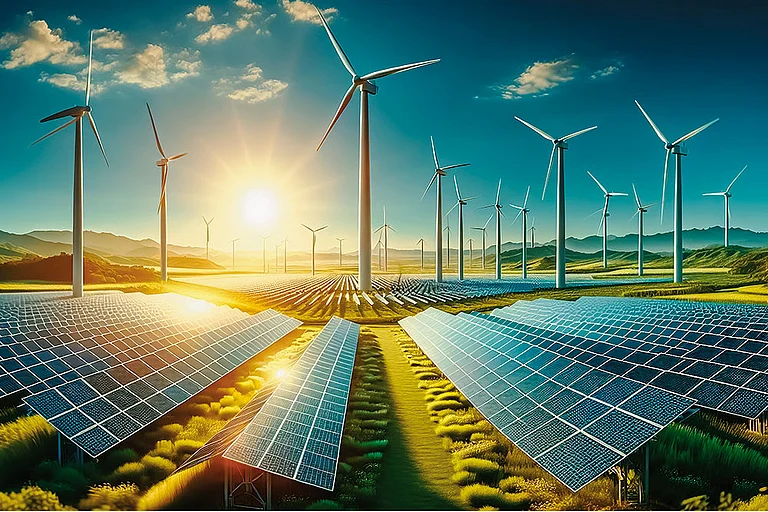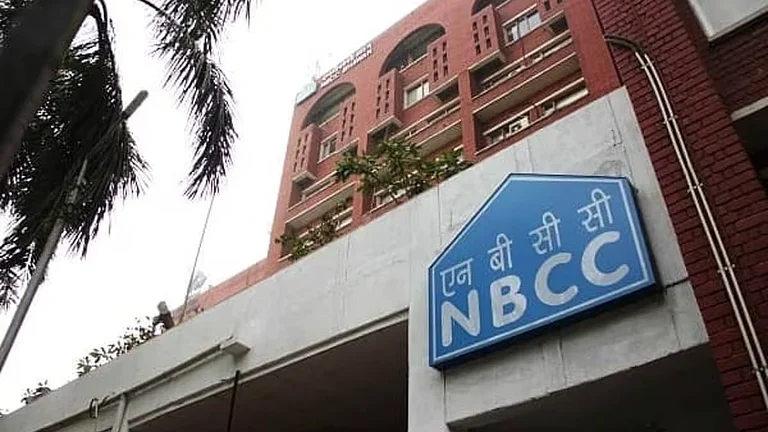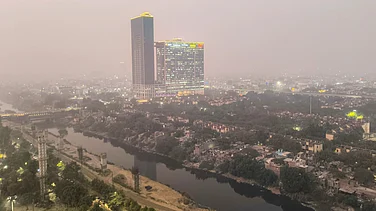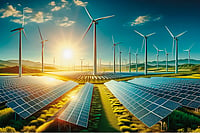India has set its sights high in the global clean energy race, aiming for 500 GW of non-fossil fuel capacity by 2030—including an ambitious 280 GW from solar alone. With 228 GW of renewable energy already installed, there is no reason why it can’t get there, except for a critical bottleneck: an ageing and overstretched transmission infrastructure.
“The pace of renewable energy capacity addition is impressive, but the misalignment between generation and evacuation represents a serious bottleneck—any delay in transmission directly slows down power evacuation, leading to lost generation potential and underutilised assets,” says Ashish Agarwal, Head of Solar & Storage at BluPine Energy.
The primary contributors to the gridlock, which threatens to unravel India’s RE story, are delays in building green energy corridors, persistent land acquisition hurdles, and outdated grid planning. As renewable projects surge ahead, the challenge now is not generation—but evacuation.
“Land acquisition, right-of-way (ROW) clearances, and technical complexities (e.g., intermittent generation integration) are key bottlenecks. These are compounded by Structural gaps exist between central (CEA, Powergrid) and state-level transmission planning,” says Pratyush Takhur, Investment Director and Country Head, Blueleaf Energy (a Macquarie GIG company).
The Great Energy Buildout vs Grim Grid Reality
However, India must reinforce its transmission backbone in step with its surging generation capacity, if the transition charge is not to trip up. On paper, the government seems to have it all covered. According to the National Electricity Plan, over 1,91,000 circuit kilometres (ckm) of transmission lines and 1,270 GVA of capacity are to be added between 2022–23 and 2031–32. Meanwhile, inter-regional transmission capacity is targeted to increase to 143 GW by 2027 and 168 GW by 2032.
But here’s the thing: “The ₹9 lakh crore plan’s success hinges on land acquisition, approvals, and private sector efficiency via TBCB/PPP models,” says Thakur of Blueleaf Energy. Meaning: The government’s projections may not be grounded in reality.
That apprehension is justified by a CEA finding: in the first ten months (April to January) of FY25 only 6,327 ckm of transmission lines were added — just 51% of the target of 12,328 ckm, and 37% lower than the 9,985 ckm achieved during the corresponding period in FY24.
“The transmission infrastructure is just not keeping pace with renewable energy growth. In order to evacuate renewable energy capacity in time, we need to move beyond traditional methods of granting approvals,” says Vishal Tripathi, Former Public Policy Expert at NITI Aayog.
Similarly, substation capacity addition have lagged way behind expectations. In the April-January period of FY25, a total of 51,500 MVA was added, which, despite being 14.7% higher than the previous year’s addition of 44,908 MVA, was still 33% below the planned target.
Anatomy of the Transmission Bottleneck
A primary issue in transmission development in India is the right-of -way. A significant amount of time is lost in obtaining land and permissions across the various parcels through which the transmission lines have to pass. The route may cut across forest land, defence zones, or a variety of private and agricultural lands.
While central transmission utilities and even private players (for projects above Rs 500 crore) have experience building such assets, the challenge lies in dealing with the multiple departments involved in granting clearances and no-objection certificates (NOCs “Land acquisition, right-of-way (ROW) clearances, and technical complexities—like intermittent generation integration—are key bottlenecks,” says Takhur of Blueleaf.
When questioned in Parliament about delays in transmission projects, Shripad Naik, Minister of State, for Power, admitted that 14 interstate transmission systems(ISTS) projects have faced delays due to right-of-way issues. Eight of the 14 affected projects belong to Power Grid Corporation of India(PGCIL) and the rest to Adani and Sterlite (two projects apiece) and Tata Power and ReNew.
Many of these renewable energy projects are stuck in a bog of state or central connectivity approvals, which can take forever. “There is also a clear mismatch between the time it takes to build a transmission asset and the time required to execute a renewable energy project. The latter can be completed in 12 to 18 months. Whereas, transmission projects can take 3-4 years, sometimes as long as six years,” says the public policy expert Tripathi. Beyond this, any unforeseeable setback, can cause indefinite delays.
Take, for example, Adani’s 700 MW hybrid project in Rajasthan, which skidded to a halt following a Supreme Court order that its evacuation line must be laid underground as it passed through the habitat of the endangered Great Indian Bustard. The diktat increased both the cost and the technical complexity of the project. It also caused substantial delays.
Risks on the Horizon
With transmission delays hindering the evacuation of power from RE projects, developers are hit by a double whammy: Curtailment and reduced returns on investment, which erodes internal rate of return (IRR) and financial viability of projects. A two-three-year delay can render a project completely unviable. Because of this, financiers now ask one key question before releasing funds: “Do you have connectivity approval?” If the answer is no, the money doesn’t come through even if there is demand, investor appetite, and available supply.
“Delays in projects also reduce visibility on their timelines, making it difficult for developers to plan and secure financing. This creates uncertainty for investors and can erode trust in the policy ecosystem. Additionally, holding costs, stranded capital, and missed revenue due to delayed commissioning weaken the financial viability of projects,” says Takhur.
More fundamentally, such delays undermine grid reliability and increases the risk of localised instability, especially in high-renewable-penetration zones.
Government Response – Will It Be Enough?
The National Electricity Plan (NEP) is a crucial step toward supporting the integration of 450 GW of renewable capacity in the coming years. The government has signalled its intent to prioritise transmission upgrades with large capital investment plans and shoutouts to the private sector to play a much larger role.
Further, state-level misalignments can also significantly impact project timelines. “Gujarat previously restricted RE generators from exporting power out of the state. More recently, states like Andhra Pradesh and Karnataka have proposed that central grid connection approvals require prior state-level registration—prioritising state interests over national planning,” says Takhur of Blueleaf Energy.
Such actions lead to uncertainty and needless headaches during project execution, holding back full utilisation of resource-rich areas. In contrast, states that have coordinated proactively with central agencies have seen smooth project rollouts.
Given how rapidly electricity demand is growing in India, some states may not fully grasp the seriousness of the problem. “If not addressed the widening generation-transmission gap could lead to frequent blackouts by 2030. This would negatively affect not only economic activity but also the political economy of the power sector. States need to understand that fixing transmission is in their interest and act proactively,” says Tripathi
Call To Action
India’s renewable energy push manifests its pledge to climate commitments and economic aspirations. But without an efficient, agile, and future-ready transmission network, even the best-laid green plans risk fizzling out. For addressing various challenges in setting up the transmission project, “Government should come up with portals like Gati Shakti for addressing RoW issue,” says Tripathi. The PMO’s Gati Shakti portal for infrastructure projects allows online payments, tracks meeting minutes, and even offers deemed approvals in case of delays. A similar national platform for transmission could enhance coordination.
But building a portal alone isn’t enough. “All central and state departments involved must be integrated with it. Gujarat has tackled the land acquisition issue by mapping all land assets through the Swamitva portal, which is part of a Government of India initiative, and implemented block chain-based mapping to make this process more efficient,” he added.
Secondly, every state must come up with a transmission plan modelled on National Electricity Plan and implement it effectively. This includes clearing land acquisition challenges in a timely manner. A cohesive response is required from the states.
Further, to accelerate the pace of renewable energy integration, “Transmission clearances should be fast-tracked through a single-window mechanism. Strengthening coordination between the Centre and states via formal joint task forces can help resolve bottlenecks more efficiently,” says Takhur of Blueleaf Energy.
Additionally, expanding grid augmentation efforts beyond RE-specific substations will allow for better optimisation of the existing power infrastructure.
India’s renewable energy ambitions are bold and achievable—but without an equally ambitious overhaul of its transmission infrastructure, they are at the risk of running into ground. The time to align generation with evacuation is now.






_1641011550.jpg?w=801&auto=format%2Ccompress&fit=max&format=webp&dpr=1.0)
























